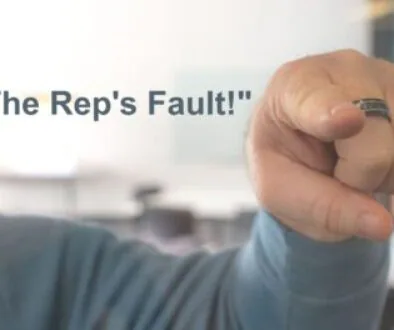Medical Sales Product Positioning – Think Before You Speak!
 You may have heard that positioning is everything. That’s true only if you want to successfully gain the attention of the decision-makers you call on and close more sales. Many sales reps use the term, but too many don’t really understand what it means or how to position their products and services. Do you think positioning is important? Positioning is everything!
You may have heard that positioning is everything. That’s true only if you want to successfully gain the attention of the decision-makers you call on and close more sales. Many sales reps use the term, but too many don’t really understand what it means or how to position their products and services. Do you think positioning is important? Positioning is everything!
Positioning, simply put is how your prospects and customers see your product, and whatever it is, it’s probably your fault. I used the word fault to get your attention, but realistically, most medical sales representatives’ positioning is flawed, that is, it doesn’t create a perception of your product that’s going to go anywhere. Most salespeople position their products exactly the same as their competition positions theirs. And the product is often positioned as to what it is or what it does, when it should really be positioned as to the pain or concern that it eliminates that is caused by a specific problem or situation. Again, notice I said pain because the key to effective positioning is relating it to what your customer or prospect is “feeling.” The key is to position emotionally before you position factually because facts don’t sell as well as emotions do.
Let me give you a specific example. Let’s say you sell a bone plate and screws that are used to repair fractures. Now, your plate is special—it has a cool design, it’s made out of a unique alloy, and the customers who are using it are happy with it. Your very biased opinion is that it is the best bone plate on the market. In fact, you like to tell your surgeon prospects just that, “Doctor…this is the best plate on the market. Look at it—isn’t it beautiful?” It’s sort of like proud grandparents who whip out their iPhones to show you pictures of their grandchildren. You look, you smile, and you say, “Wow…good looking kids” but the truth is that what you’re really thinking is, “Yup…those are children.” Here’s what a surgeon thinks when he or she is looking at a bone plate with plain vanilla positioning: “Yup, it’s a bone plate,” regardless of how beautiful or special it is in your eyes.
So if you say to Maggie, the receptionist in Dr. Carlson’s office, “Hi Maggie. Does Dr. Carlson have two minutes for me to show him my new bone plate?” How have you just positioned your bone plate? You just positioned it as a freakin’ bone plate! How exciting do you think that’s going to be to Dr. Carlson? Probably about as excited as you would be if Dr. Carlson showed up at your house while you were doing something important to show you pictures of his grand kids! Just like you’re not thinking, “I’d really like to see pictures of grandchildren, Dr. Carlson isn’t thinking, “I hope a salesperson comes by to show me a bone plate.” You can’t position your product generically because when you do, you lose!
The truth is, Dr. Carlson and all of your other customers don’t want to see products. They want a solution to make their pain go away or to achieve their objectives. How can your bone plate do that? Okay, I can sense that you’re thinking about this. You know that the shape of your bone plate makes it easier to seat on the bone without a lot of manual contouring. That makes it easier to use. So you might be thinking, “Okay, I’ll position my product as being easier to use. Surely, Doctor Carlson wants a bone plate that’s easier to use, right?” Well, let’s think about that for a second. Dr. Carlson is a surgeon with an enormous amount of confidence. The last thing he thinks about when putting on a bone plate is, “Ohhh, that’s going to be hard.” He’s just not worried about that. It’s as if I tried to sell you a teaspoon that doesn’t drip. That it is drip-proof might be true from a factual perspective, but unless you have spots on your clothes from dripping teaspoons, you’re not going to care because it’s not an issue or problem for you.
So what things about a device drive surgeons crazy during a surgical procedure? What makes them angry? Many surgeons don’t like devices that are complicated. They don’t like learning curves, which they sometimes refer to as “the fiddle factor.” What emotions do they feel when they experience “the fiddle factor?” How about frustration? Maybe anger. Maybe a concern that they are going to be late for the next surgery or their office hours. Or they’ll fear that the patient might not get a good result. All are ideal emotions to tap into with your product positioning..
Let’s say you know that Dr. Carlson’s pet peeve is when surgeries take too long. To him, time is money and when it takes longer to do a simple procedure it frustrates the heck out of him. He likes people and products that save him time and help him to avoid frustration. Got it?
So let’s look at that bone plate of yours again, this time with Dr. Carlson’s temperament and preferences in mind. How might you position it? How about as a fixation device that reduces frustration in the OR while reducing surgical time an average of 30%. Dr. Carlson has zero interest in a bone plate, but he’s always interested in saving time and avoiding frustration. These are his key buying motives. Position your product that way and you have his attention.
Should you position your product to other prospects the same way? Only if they have the same buying criteria as Dr. Carlson. Always position your product or service so as to address the real, emotional buying concerns of your customers.
How do you determine a prospect’s or customer’s buying criteria? Well gosh, that’s another element of your medical selling skills, isn’t it.
Positioning, that is, sales positioning IS everything. Determine now whether you or your sales team can position your products and services effectively or you will be outsold by competitors who can.



@ 7:14 pm
What is your position on positioning? Please share with a comment here. Thanks!
@ 12:44 am
Hi Mace, I love reading your blog and keep checking it for updates. You haven’t written in a long while. So this new write-up was really refreshing at the start of the new year. I do implement sales positioning in my everyday work and the returns do hike up. Your article gave me a confidence boost. Healthcare professionals have no time and you need catch their attention in order for them to listen. An emotional connection gets them obligated to buy from you at times or it helps you get a recommendation definitely. Do keep writing.